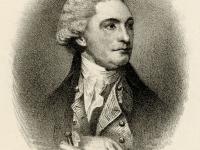Answer: The Bank of North America
Wealthy merchant and landowner William Bingham was born in 1752. His father, William, was a merchant and a veteran of the French and Indian War. Bingham attended the College of Philadelphia (now the University of Pennsylvania). After graduation he apprenticed under merchant Thomas Wharton and subsequently joined the firm Willing, Morris, and Company.
In 1775, Bingham became the secretary of the Committee of Secret Correspondence, formed by the Continental Congress. In 1776 Bingham traveled to Martinique, where he advanced the American cause. Bingham remained in Martinique until 1779, during which time he amassed a considerable fortune by making consignments for Willing and Morris and handling their West Indian trade. Upon his return to the United States, Bingham, not yet thirty years old, was one of the richest men in the country.
Bingham founded the Pennsylvania Bank, the first bank in the United States, which was soon replaced by the Bank of North America. The Bank of North America was established primarily to aid Congress in providing supplies and money for the prosecution of the Revolutionary War. In 1916 the bank bought the assets of the National Bank of the Northern Liberties; in 1923 it merged with the Commercial Trust Company to form the Bank of North America and Trust Company; six years later the merged institution was itself absorbed by the Pennsylvania Company.
Image: Portrait of William Bingham

